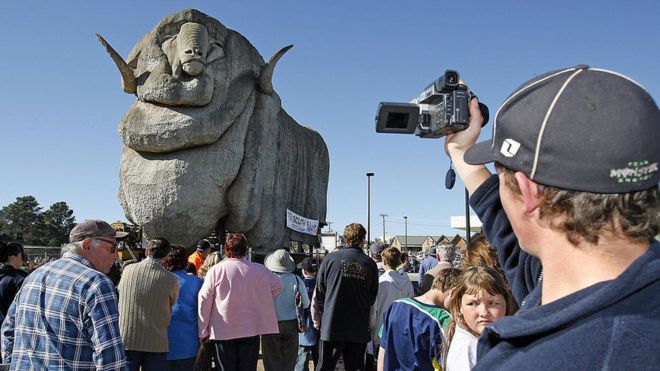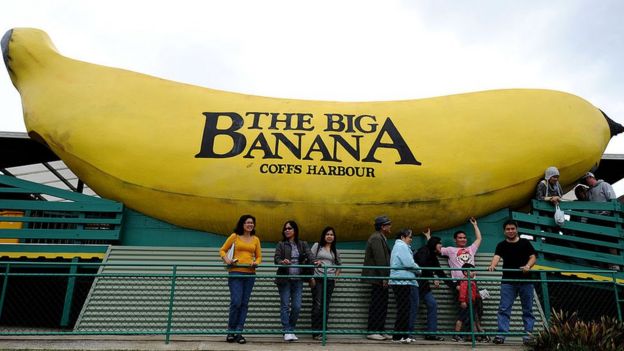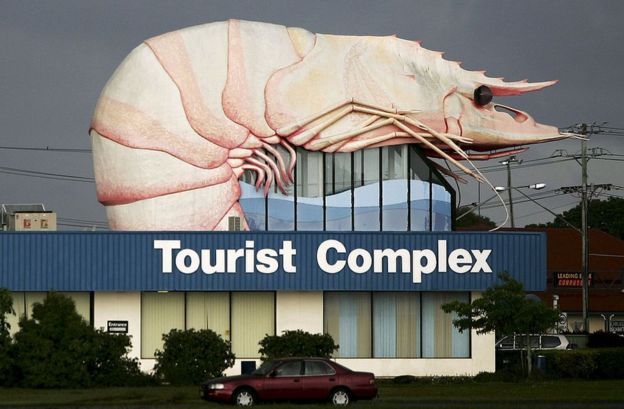 GETTY IMAGES
GETTY IMAGES
In the low-budget 1987 Australian horror film Dark Age, a ranger, played by Wolf Creek star John Jarratt, tracks a rogue saltwater crocodile. Four decades on and the film, or more particularly one of its props, continues to scare and enthral.
At a whopping 9m (30ft) long, Ron the giant fibreglass croc sits proudly at Hartley's Crocodile Adventures at Wangetti Beach in Far North Queensland, which bought the mould for the large reptile from the makers of the movie. Ron is part of the quirky Australian tradition of building big models and monuments, from the Big Banana to the Big Merino and Big Prawn.
Ron has a few metres on the largest real crocodile ever caught in Australia - a 5.48m giant dubbed Cassius. But Angela Freeman, co-owner of Hartley's, says tourists "absolutely love it".
"The little darling has recently been repainted and refurbished, and has brand new glass eyes bought for him," she says. "He's a great attraction."
 ANGELA FREEMAN
ANGELA FREEMAN
There are dozens of large statues in every Australian state and territory that celebrate a beguiling array of mushrooms, guitars, ants, mosquitoes, worms and the outlaw Ned Kelly, and much more.
A Christian organisation recently announced plans to build a huge illuminated cross on top of a hill in a remote corner of central Australia. It would be about 22m high and be illuminated on land near the Aboriginal community of Ikuntji, 230km (143 miles) west of Alice Springs.
Other monuments salute local produce or industries, such as the 6m Big Miner in Ballarat, while others are marketing gimmicks for shops and motels.
"They pop up all over the place. You're driving along and suddenly you see this 6m-high lobster," says Patti McCarthy, who runs Cultural Chemistry, a company providing cross-cultural training for expatriates either moving to or leaving Australia. "The tourists love them and they all flock to see them, and have their photographs taken with them."
She says the monuments reflect Australia's often mischievous - or larrikin - spirit. "Anyone would think it was a bit cheap and nasty and in bad taste, but we like it," she says. "Australians have got a great sense of humour and a very laid-back self-deprecating style."
 GETTY IMAGES
GETTY IMAGES GETTY IMAGES
GETTY IMAGES
But not everyone is so warmly appreciative. Kent Watson, from Monument Australia, which studies the historical value of the nation's public memorials and statues, believes the likes of the Big Kangaroo, Big Lamb and Big Potato can be a nuisance.
"I find many of them to be unattractive and often a blight on the landscape," he says. "Some communities erect some 'big' structures to emphasise something about their place, such as its agricultural or pastoral produce. I am sure communities had good reasons to build them, and that they serve some purpose, but just as a personal opinion I think they are as intrusive as roadside advertising signs."
No comments:
Post a Comment